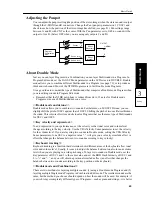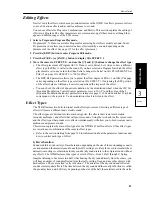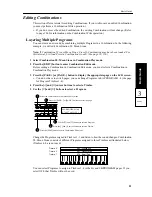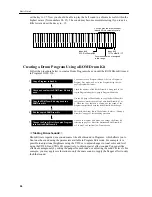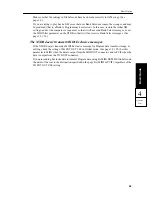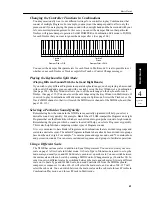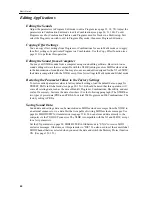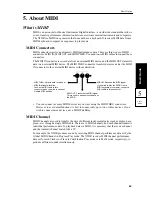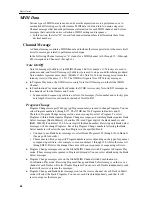
Basic Guide
58
You cannot change Programs or Combinations.
Program Change messages are used to change Programs and Combinations. Make sure that the
messages are sent from the transmission device.
In Program Play mode: Send Program Change messages on the Global MIDI Channel. If you wish
to change the Bank, send a Bank Select message. (See page 22.) Also, check the MIDI Filter
setting in Global mode. (See page 152.)
In Combination mode: To change the Combinations, send Program Change messages on the
Global MIDI Channel. If you send Program Change messages or Bank Select messages on each
Timbre’s MIDI channel, the Program for the corresponding Timbre will be changed. (See
page 151, 102.) Also, check the MIDI Filter setting in Global mode and in the Combinations. (See
page 152, 111.)
In Multi mode: Send Program Change or Bank Select messages on each Track’s MIDI channel.
Also, check the MIDI Filter setting in Global mode and Multi mode. (See page 152, 111.)
The wrong sounds are produced.
You need to write the edited parameter values to memory to store the Program edited in Program
Edit mode or the Combination edited in Combination Edit mode. If you select another Program
or Combination without saving the edited data, the edit will be lost. (See page 39, 99, 106.) You
do not need to carry out the Write function to store the edited Drum Kits.
When you are editing a Drum Kit, the parameter settings of the Program selected in Program Play
mode are used to produce the sound. If you use a Drum Kit in a Program that is different from the
one selected when editing, a different sound will be produced. (See page 53.) Make sure that you
select the Program that was selected when you edited the Drum Kit.
Combinations remember the Program for each Timbre as a Program number, not as a sound. If
you edit the Program used for the Combination or if you select a different Program for the
Combination, the sound of the Combination will be also changed.
You cannot write a Program or Combination.
Check the Memory Protect setting in Global mode (see page 153.). You cannot write a Program
or Combination if the Memory Protect parameter is set to ON.
You cannot select the parameter pages for OSC2 (e.g., VDF2 and VDA 2).
If the screen does not display the pages for OSC2 in Program Edit mode, check to see whether the
Oscillator mode is set to DOUBLE. (See page 79.) If this mode is set to SINGLE or DRUMS, you
cannot select the pages for OSC2.
The X5DR does not play the specified drum sounds.
If an incorrect drum sound is produced when the correct note messages are sent, the Transpose
parameter may have been set to a number other than 0. Check whether TRANSPOSE in Global
mode is set to +00. (See page 147.) Also, check to make sure that the octave setting is 8'. (See
page 80.)
When you are using a computer or sequencer, check that the Transpose parameter on the
transmission device is set to 0. Usually, the sequencer or sequencer software automatically sets the
Transpose on MIDI channel 10 to off. However, double-check this parameter if you have sent edit
commands to transpose, or if you are playing on tracks other than Track 10 in Multi mode.
The X5DR does not play GM-compatible song data correctly.
Make sure that the song data is GM-compatible.
Make sure that the Multi mode settings have been initialized for GM. (See page 28.) You can
restore the initial GM settings by sending a GM System On message to the X5DR in Multi mode
or by using page 23A SET TO GM.
Содержание X5DR AI2 SYNTHESIS MODULE
Страница 1: ...GENERAL INSTRUMENT AI 2 SynthesisSystem 1 E Owner s Manual AI 2 SYNTHESIS MODULE ...
Страница 7: ...Controls vi ...
Страница 13: ...About this manual xii ...
Страница 156: ...Reference Guide 143 Reference Guide Effect Parameters 4 ...


